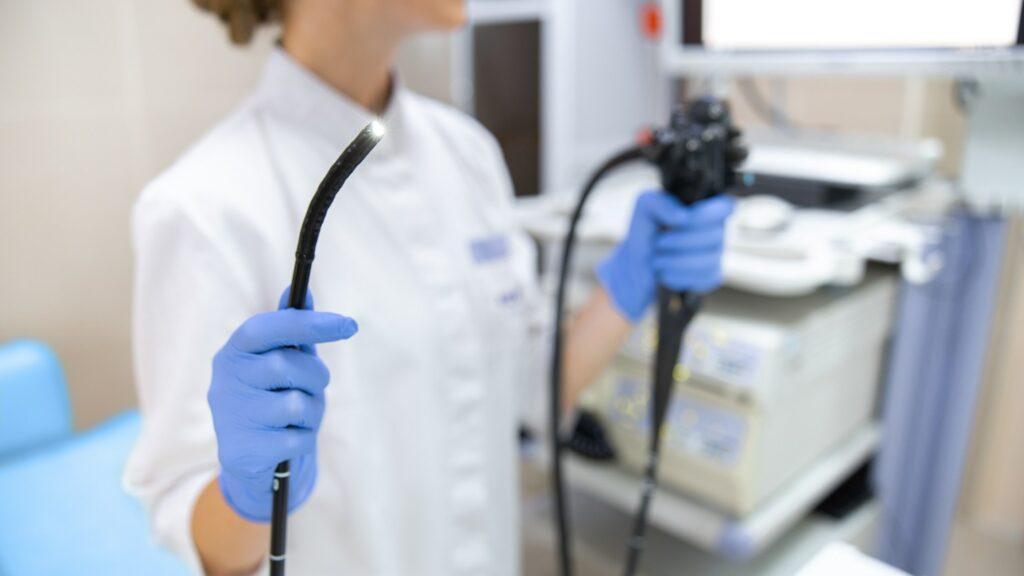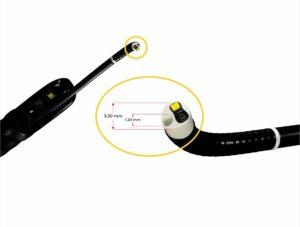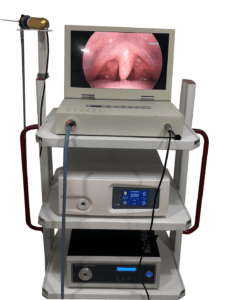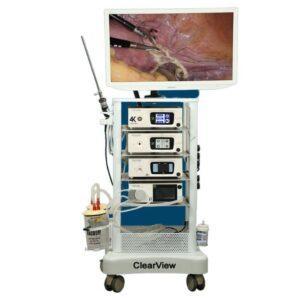In this blog, you’ll know about different types of endoscopes and their uses & benefits. You’ll also know the medical procedures such as upper endoscopy, colonoscopy, and endoscopic retrograde cholangiopancreatography. Additionally, we’ll discuss the importance of maintaining endoscopes to ensure patient safety.
But first, let’s introduce Medzell, a futuristic B2B platform that promotes Indian medical devices in emerging markets. Medzell is helping healthcare providers around the world access high-quality medical equipments.
What Are Endoscopes ?
Endoscopes are those medical devices which are used by doctors to see inside the body. They consist of a long, thin, flexible tube with a camera and light attached to one end, which is inserted through a natural opening or small incision in the body. Endoscopes allow doctors to see areas that are difficult to reach with the naked eye. They are also used for treatment purposes, such as removing polyps or taking biopsies. Endoscopes have revolutionized modern medical field and are now widely used in a variety of medical procedures.
Types of Endoscopes
Flexible Endoscopes
Flexible endoscopes are long, thin and flexible tubes with a camera and a light source at the end that can be inserted inside the body to take images of the internal organs. The images are transmitted to a monitor which allows medical professionals to view them live. Flexible endoscopes are commonly used for diagnosing and treating conditions of the digestive system. One of the main benefits of flexible endoscopes is that they do not require large incisions or open surgery. This results in less pain and a shorter recovery time. However, flexible endoscopes also have some drawbacks. They can be difficult to put in some areas of the body.
Rigid Endoscopes
Unlike flexible endoscopes, rigid endoscopes are straight and inflexible, and they do not bend. They are used primarily for examining the inside of joints, such as the knee or shoulder. Rigid endoscopes have a series of lenses and mirrors that reflect the image of the joint onto a monitor, allowing medical professionals to see inside the joint without making an incision. Rigid endoscopes are considered to be more accurate as they provide a clear and more detailed image of the joint.
Capsule Endoscopes
A capsule endoscope is a small, swallowable capsule that contains a camera and a light source. It is used primarily for examining the small intestine, which is difficult to reach with traditional endoscopes. The capsule is ingested by the patient and passes through the digestive system, taking pictures along the way. The images are transmitted to a monitor, allowing medical professionals to view them live. Capsule endoscopes are minimally invasive and do not require any incisions or anesthesia. They are also painless. However, they have limitations of not to be able to diagnose certain conditions, as they cannot take biopsies or remove polyps.
Video Endoscopes
Video endoscopes are a type of endoscope that use digital technology to capture and transmit images. Video endoscopes have a small camera that captures images and transmits them to a monitor. They also have a video processor that enhances the image quality and allows for digital zooming and panning. Video endoscopes are used in different medical procedures including gastrointestinal endoscopy, bronchoscopy and arthroscopy. They provide high-quality and more detailed images that are clear than those of traditional endoscopes. They are also easier to use.
Endoscopic Procedures
Upper Endoscopy
In an upper endoscopy, the upper digestive system is examined including the esophagus, stomach and duodenum (the first part of the small intestine). The procedure is performed using a flexible endoscope that is inserted through the mouth and the throat.
- During the procedure, the patient is typically given sedation to procedure comfortably. The sedation is usually given through an IV in the patient’s arm and will help the patient feel relaxed and drowsy.
- Once the sedation is given, the endoscope will be inserted through the patient’s mouth and the throat. The endoscope is a long thin tube with a light and camera at the end which allows the doctor to see inside upper digestive system. The doctor will use the endoscope to see the lining of the digestive duct, looking for any abnormalities or signs of disease.
- During the procedure, the doctor may take small tissue samples. They may also remove small polyps or growths if necessary. It is important to follow instructions provided by the doctor such as avoiding food and drink for a certain period or taking any prescribed medication.
Colonoscopy
Colonoscopy is that medical procedure which is used to examine the large intestine or colon. It is used to detect colon cancer.
- What to Expect During a Colonoscopy: Before the procedure, patients will be instructed not to have food for sometime. During the procedure an endoscope will be inserted. The endoscope has a tiny camera at the end which transmits images to a monitor allowing the doctor to examine the inside of the colon. If the doctor detects any abnormalities, they may take a small tissue sample or remove polyps, which are small growths that can sometimes develop into cancer.
- Discover the advantages and potential risks associated with Colonoscopy: Colonoscopy is very important procedure for detecting colon cancer. By detecting and removing polyps early, the risk of developing colon cancer can be greatly reduced. However, the procedure does have some risks. In rare cases, the endoscope can cause a tear or perforation in the colon.
- What to Expect After a Colonoscopy: After the procedure, patients will be monitored until the sedative wears off. Patients may have some bloating but it should go away within a few time. Patients should also receive a detailed report of colonoscopy from the doctor.
Endoscopic Retrograde Cholangiopancreatography
Endoscopic Retrograde Cholangiopancreatography is a medical procedure that is used to diagnose and treat conditions of the bile and pancreatic ducts. During the procedure, a special endoscope is used to inject a dye into the ducts which helps doctor to see clearly.
- What to Expect During ERCP
Before the procedure, patients will be instructed not to take food for sometime. During the procedure, the patient will be given sedative drugs and a flexible endoscope is inserted through the mouth into the digestive duct. A small incision is then made in the duct, and a dye is injected to highlight the duct on x-rays. If any blockages or abnormalities are detected, the doctor may perform a procedure to remove the blockage or place a stent to keep the duct open. - Benefits and Risks of ERCP
ERCP is a very effective procedure for diagnosing and treating conditions of the bile and pancreatic ducts. By detecting and treating blockages early, the risk of developing serious complications can be greatly reduced. However, the procedure does have some risks. In rare cases, the endoscope can cause a tear or perforation in the ducts. - What to Expect After ERCP
After the procedure, patients will be monitored until the sedative wears off. Patients may experience some bloating but it should go away within a few time.
Patients should also receive a detailed report from the doctor having the results of the ERCP and any further steps that may be necessary.
Endoscopic Accessories
- Endoscope Cleaning Brushes: Endoscope cleaning brushes are specialized tools used to clean the internal channels of endoscopes, which are used in medical procedures to examine the inside of the body. These brushes come in a variety of sizes and shapes to fit different endoscope channels and remove debris and bacteria from hard-to-reach areas. Proper cleaning of endoscopes is important to prevent the spread of infections and ensure patient safety.
- Endoscope Storage Cabinets: Endoscope storage cabinets are designed to store endoscopes safely and securely between uses. These cabinets are typically made of stainless steel and feature specialized racks and hooks to hold endoscopes and their accessories. Some endoscope storage cabinets also have built-in drying systems to help prevent the growth of bacteria and fungi. Proper storage of endoscopes is important to ensure that they remain clean and in good working order, and endoscope storage cabinets are an essential part of endoscope reprocessing.
- Endoscope Leak Testers: Endoscope leak testers are devices used to test the integrity of endoscope channels and ensure that they are functioning properly. These testers use water or air pressure to detect leaks or blockages in the channels, which can lead to inadequate cleaning or damage to the endoscope. Regular leak testing is an important part of endoscope reprocessing to ensure that the instruments are working correctly and to prevent patient harm. Endoscope leak testers are available in various sizes and configurations to accommodate different endoscope types.
Endoscopes from Leading Indian Manufacturers
mBLU HD Video Cholangioscope (OBS-IN+)
mBLU HD Video Cholangioscope (OBS-IN+) is manufactured by Mitra Industries Private Limited, this cholangioscope features a super bright LED-at-tip, providing a 30% increase in brightness and a 15% wider spread. The newly developed phosphor coating on the LED substrate enhances the lighting. With exceptional picture quality from the CMOS sensor, you can easily observe even the finest details. The 120-broad field of view makes it easier to see the mucosal pattern while bending the tube, and simple manipulations are possible. The cholangioscope is compatible with lasers and is slim, flexible, and ergonomic for smooth insertion. It also features a single-click connector, making it easy to connect and disconnect.
OPD 12” Endoscopy System
OPD 12” Endoscopy Systemby Meditrax Equipments is a state-of-the-art rigid and advanced combo unit that includes an HR camera, light source, and HD display all in one. It is made in India and is easy to operate and carry anywhere. The HR camera gives you very good crisp and clear picture quality with its CCD SONY chipset from Japan. This chip has a 1200TVL high resolution, providing you with very good depth of field of the picture and clear picture quality. You can also freeze the picture whenever you want by pressing the freeze key, which is a very helpful function for diagnostics.
The camera head design is very handy and easy to operate, and it comes with adjustable white balance by pressing a key. The 12” IPS HD display is medical grade and offers high color accuracy for better examination. The LED light source has a 60 W cold LED with a 6500k LED color temperature. The OPD 12” Endoscopy System is a remarkable unit for remote examination, OPD, and diagnostics.
UL-UHD-ClearView 4K Endoscope Tower
UL-UHD-ClearView 4K Endoscope Tower is an innovative product developed by UnivLabs, a reowned manufacturer and supplier of endoscopes in India. This tower stands out as the world’s first cloud-connected 3 Chip 4K Laparoscopy tower, offering exceptional specifications. With four times higher resolution than full HD, it provides sharper details on a wider 32″ screen 4K surgical monitor. The tower includes a Surgical 4K Ultra high-definition camera, surgical LED light source, CO2 insufflator, endoscopes, couplers, and a universal medical irrigation pump. The advanced 3 Chip CMOS technology and premium optics of the UL-4K ClearView ultra high-definition camera system capture lifelike images of the surgical field. It also offers nine preset surgical specialty settings for quick configuration. The LED technology of the tower enhances the use of the Light Source in the operating room, with features like FOC-Tip (TM) Disconnect detection for patient safety. The CO2 insufflator, UL50-D, ensures rapid pneumoperitoneum creation with optimal safety using Safe VENT® & DualDome technology. The UL-10-330-4K rod lens telescope captures detailed and sharp images, optimizing focus on the tissue of interest. The UMP-2000 provides safe and reliable performance in irrigation, suction, and intra-cavitary distension. Equipped with auto self-test and precise bubble detection technology, it ensures patient safety during surgery and monitors fluid absorption.
Medzell – Promoting Indian Medical Devices in Emerging Markets
Medzell is a futuristic B2B platform that aims to promote Indian medical devices in emerging markets. The platform connects medical device manufacturers with buyers and distributors from around the world, providing a unique opportunity for Indian manufacturers to expand their reach and tap into new markets.
Medzell’s platform is designed to be easy to use, with a streamlined interface that makes it simple to search for and purchase medical devices. The platform also offers a range of value-added services, including logistics and regulatory support, to help manufacturers navigate the complex process of exporting medical devices.
With its focus on emerging markets, Medzell is uniquely positioned to help Indian medical device manufacturers tap into new opportunities and grow their businesses. By leveraging the power of technology and a deep understanding of the needs of both manufacturers and buyers, Medzell is helping to shape the future of the medical device industry in India and beyond.
Conclusion
In conclusion, the advent of endoscopes has brought about a transformative impact on medical diagnostics and therapies, delivering a non-intrusive approach for visualizing and accessing internal organs and structures. With the progress of technology, endoscopes now provide high-definition imaging, improved maneuverability, and enhanced patient comfort. From gastrointestinal procedures to respiratory examinations, endoscopes have become indispensable instruments within the medical domain. As research and innovation persist, we can anticipate even more remarkable advancements in endoscopy, ultimately leading to enhanced patient outcomes and superior healthcare practices. By embracing the potential of endoscopes, healthcare professionals can continue to embark on novel frontiers in diagnosis, treatment, and patient care.





